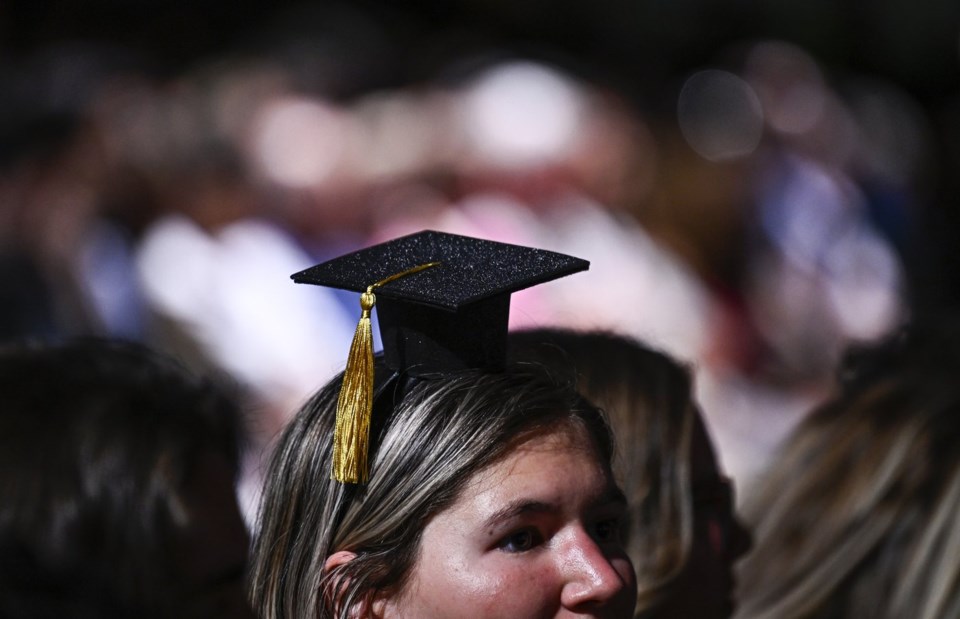Paying back student loans has always been a challenge, but at a time when housing and meals eat up a bigger slice of income than ever, making smart choices around loans and repayment is all too critical.
So say financial experts urging young Canadians to rein in debt incurred during college and university, and aiming to skewer misconceptions around it.
“The cost of rent has skyrocketed, the cost of food has skyrocketed,” said Joey Kindarji, an associate portfolio manager at Wealthsimple.
“Even if the debt was the same as it was in the past, it's actually harder to pay it off today.”
As the cost of living rises, students have a range of options to lighten their debt load, from being choosy with lenders to laying out a budget.
One first step is to set a target ceiling for total debt over the course of your studies, with the sum sitting no higher than your expected annual salary after convocation.
According to Statistics Canada, the average recent graduate of a bachelor's degree program owed about $30,600 in student debt as of 2020. (That's higher than the average debt of $26,300 from 2010, but amounts to a real value 16 per cent below 2010 levels due to inflation.)
“If you’re a doctor and you’re going to make a lot, it’s OK to get a bit more into debt, knowing you have more chance of repaying,” Kindarji said.
To keep interest costs down, borrowers should look to federal and provincial governments as their go-to source, opting for bank loans only if necessary. Interest paid on government loans qualifies as a tax credit, and the state also offers more generous support options.
“A traditional bank has interest and they charge it from the start,” said Joshua Harris, a licensed insolvency trustee at Harris & Partners. “They’re not your friend.”
Look for ‘free money’
Harris recommends students apply for as many grants, scholarships and bursaries as they can, as many applicants wind up with more cash than expected.
“A debt is a debt, and you will have to repay it” — no matter how low the interest — he noted. “So take the opportunity to pay less.”
While some experts say there’s no harm in paying off a portion of debt during your studies — so long as it doesn’t compromise educational priorities — others argue for borrowing as much as you can from the government at zero per cent interest and then putting a small chunk in safe investments such as high-interest savings accounts or Guaranteed Investment Certificates.
“You can make a bit of interest on it and then have the money down the line to pay it back — kind of free money to invest,” said Kindarji.
Those who take that route should keep in mind that interest rates on such loans typically start to tick up six months after graduation, he added.
Other tips for debt reduction include opening a hybrid savings-chequing account for higher interest — up to five per cent — and taking a gap year or semester off to work and save.
To keep a lid on debt, high school students can even look for college- and university-level credits available via Advanced Placement courses. That can result in tuition savings if fewer classes are needed down the line.
Repayment
Step one for chipping away at a loan begins with sketching out a monthly budget.
“You have to really think about your lifestyle costs and where you need to make some sacrifices,” Kindarji said.
“That could mean being a bit more frugal with your money, that could be living with someone else or living back at home with parents … Think of a budget and then try to tackle the debt as quickly as possible.”
That arithmetic includes calculations around interest payments, which can add up quickly. “If I pay $100 a month for five years, I paid $6,000 (in interest),” said Harris.
For those struggling to make those payments, income-driven plans available through provincial and federal governments allow for a more flexible approach tied to your earnings.
Applicants to the federal Repayment Assistance Plan may qualify for reduced payments or none at all, depending on income. If approved, the government will pay any interest owing on the part of the student loan that a reduced payment fails to cover, among other measures.
“They should be taken advantage of in scenarios where you need them,” Harris said of the repayment plans.
What to avoid
Do not take out loans to pay off student debt. “That does not make sense,” Harris said.
“The problem with that is there are government programs that allow you to repay your student loans,” he said, with banks being less forgiving.
Experts also advise against refinancing if possible. But if you’re juggling a bundle of loans, including private ones, that may be a sensible option.
“Refinancing or debt consolidation is generally recommended when there are a high number of debt products to manage, or if the monthly repayment amount is causing strain on budgeting for other living expenses,” said Jennifer Bishop, a vice-president at Toronto-Dominion Bank.
Finally, do not pay a debt consultant for advice, says Harris — who does not charge for consultations.
“Nothing up front,” he said. “You can call anonymously to a trustee’s office and they will give you that answer.
“Don't be shy.”
This report by The Canadian Press was first published July 4, 2024.
Christopher Reynolds, The Canadian Press

